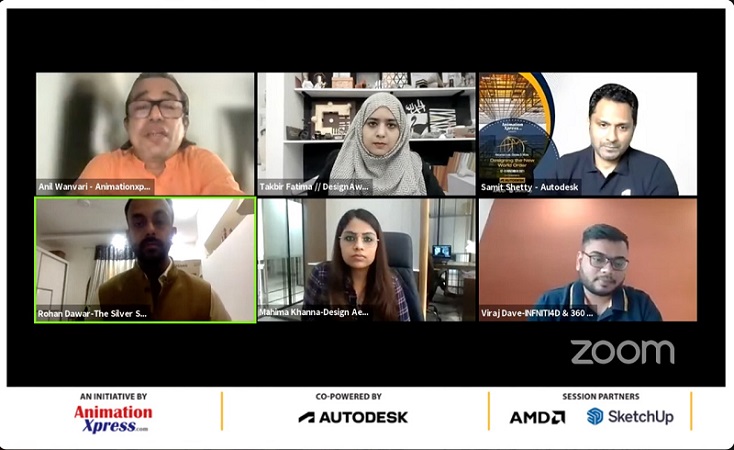Day two of the ADM Summit 2021 witnessed quite a few engrossing sessions and discussions. Keeping up with the virtual event’s theme of ‘new technology’, an expert panel consisting of the industry veterans shared their viewpoints on the future of design visualisation and how architecture is keeping up in the present times.
The panelists were: Autodesk India technical solutions manager – M&E Samit Shetty, Design Aesthetic creative director Mahima Khanna, Design Plus Architects partner Abhishek Bij, The Silver Sea director Rohan Dawar, Designaware director Takbir Fatima and Infniti4d & 360 Eye MD Viraj Dave. The session was moderated by AnimationXpress founder, chairman and editor-in-chief Anil Wanvari.
Setting the tone right for the enriching discussion, Dave commenced the session by taking the viewers to where it all started. “In the early 90s, people used to make 3D models which showed how a project would look. Then in 1996, Autodesk’s software 3ds Max came into the picture and it is still extensively used for 3D rendering. This technology has been in the run for the last 25 years and there’s hardly any replacement in the market for the superlative software” affirmed Dave.
“Blueprints for me are like blue and black lines, they are not convincing. 3D makes everything easy and possible. You can see exactly how the project will look and quickly make any number of changes. The clients will always ask for more options when you show them a design and 3D ensures that multiple options are always ready. Technology has grown big time, content creation has come a long way, the tools are easier, and we’ve added a lot of automation,” Shetty rightly mentioned. Autodesk, as they say, is definitely changing how the world is designed and made.
Khanna shared how building up commercial spaces is completely different from what residential clientele is. However, there is no denying that in both cases, imaginations can be brought closer to actualities by riding on the back of technological provisions. 3D modeling has elevated the workings of the architecture design industry and architecture presentation has immensely benefited by the same.
Dawar added, “3D designs are important not only for the client, but also for the person who is executing the project. The executor would understand the complexity of the entire project and the client would know that if we are putting in so much effort in creating the 3D design, the output has to be super-awesome from the executor as well.”
With 3D architecture models you can easily recognize the effect in the overall design that is made by both major and minor changes. Thus, designs can be finalized without incurring much cost. Also, more accuracy is obtained as the final construction materializes to the perceived outcome. Speaking from experience, Fatima commented, “From the client’s point of view, 3D designs make it very easy to show multiple options or see how the space looks. It also helps in making quick changes in design. We use VR tools for experiential presentation of the design. So, instead of just being able to see the model, the client is able to experience it, walk through it, and interact with it. It becomes a more immersive experience for them.”
While chewing over the importance of VR in architecture and design, we cannot disregard mixed reality (MR). MR combines the virtual and the physical realities into one space and offers an exciting new design paradigm for architects. As Bij aptly pointed out, “Mixed reality is defining the future.”


